Global Metaverse Market: By Component, By Industry Vertical, By Region & Segmental Insights Trends and Forecast, 2024 – 2034
- Industry: Technology
- Report ID: TNR-110-1142
- Number of Pages: 420
- Table/Charts : Yes
- June, 2024
- Base Year : 2024
- No. of Companies : 10+
- No. of Countries : 29
- Views : 10245
- Covid Impact Covered: Yes
- War Impact Covered: Yes
- Formats : PDF, Excel, PPT
The metaverse is a collective virtual shared space, created by the convergence of virtually enhanced physical reality and physically persistent virtual spaces, including the sum of all virtual worlds, augmented reality, and the internet. It represents a digital universe where users can interact with a computer-generated environment and other users in real-time, using avatars and immersive technologies such as virtual reality (VR) and augmented reality (AR).
The metaverse encompasses various digital domains, from virtual gaming worlds and social platforms to virtual workplaces and marketplaces, allowing for diverse activities and interactions. As an evolving concept, the metaverse is driven by advancements in technology, including AI, blockchain, and high-speed internet connectivity. This digital frontier aims to enhance the way we socialize, work, learn, and entertain ourselves, providing an integrated and immersive digital experience that bridges the gap between physical and virtual realities. The metaverse promises to transform numerous industries by enabling new forms of digital interaction and commerce.
The demand for the metaverse is driven by several key factors, including rapid technological advancements, shifting consumer preferences, and increased investment from major tech companies. Innovations in augmented reality (AR) and virtual reality (VR) technologies are making immersive digital experiences more accessible and engaging, attracting a growing user base. Consumers are increasingly seeking new ways to socialize, work, and entertain themselves within digital environments, driven by the pandemic’s acceleration of remote activities and virtual interactions.
Additionally, significant investments from tech giants like Meta (formerly Facebook), Microsoft, and Google are fuelling the development of sophisticated metaverse platforms, further expanding their capabilities and appeal. The rise of digital economies, facilitated by blockchain and non-fungible tokens (NFTs), is also propelling demand, as users seek to buy, sell, and trade digital assets within the metaverse.
In terms of revenue, the global metaverse market was worth US$ 92.5 Bn in 2023, anticipated to witness CAGR of 47.2% during 2024 – 2034.
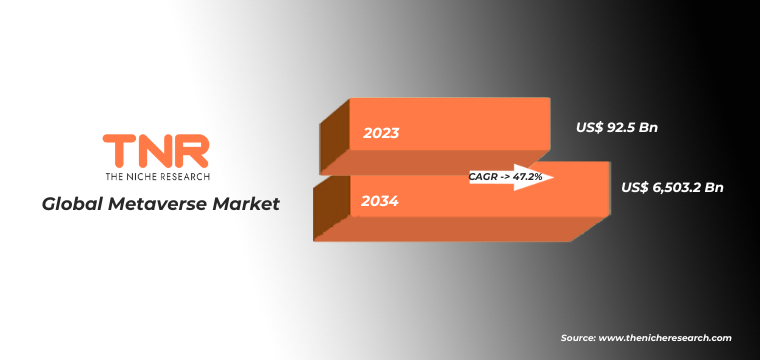
Global Metaverse Market Dynamics
Technological Advancements: Continuous innovations in augmented reality (AR), virtual reality (VR), blockchain, and artificial intelligence (AI) are critical drivers, enhancing the immersive experiences and functionality of the metaverse. The rise of cryptocurrencies and non-fungible tokens (NFTs) integrates with the metaverse, enabling new forms of digital ownership, commerce, and virtual economies.
Consumer Demand: There is a growing consumer appetite for immersive digital experiences, from virtual gaming and entertainment to socializing and shopping in virtual environments. This demand propels the development and adoption of metaverse platforms. The COVID-19 pandemic has accelerated the adoption of remote work and virtual collaboration tools, increasing the relevance and utility of metaverse environments for professional and educational purposes.
Investment from Major Tech Companies: Leading technology companies like Meta (Facebook), Google, Microsoft, and Apple are investing heavily in metaverse technologies, accelerating market growth and technological development. The expansion of high-speed internet access and the deployment of 5G networks are vital for supporting the data-intensive applications of the metaverse, enabling smoother and more responsive user experiences.
Cybersecurity and Privacy Concerns: Ensuring the security and privacy of users in the metaverse is a critical challenge, as the potential for data breaches and cyber-attacks increases with the complexity and scale of virtual environments. The need for interoperability between different metaverse platforms and the establishment of industry standards pose both challenges and opportunities for cohesive growth and user experience enhancement.
Hardware Segment has Garnered Major Market Share in the Global Metaverse Market During the Forecast Period (2024 – 2034).
The demand for hardware in the metaverse is driven by several critical factors, including advancements in technology, the growing popularity of immersive experiences, and the need for powerful computing capabilities. As the metaverse evolves, it requires sophisticated hardware to support its complex, interactive environments. High-performance devices such as virtual reality (VR) headsets, augmented reality (AR) glasses, and advanced gaming consoles are essential for providing the immersive experiences that users expect. These devices must offer high-resolution displays, seamless connectivity, and intuitive interfaces to ensure an engaging and realistic experience. Additionally, the development of powerful GPUs (graphics processing units) and CPUs (central processing units) is crucial for rendering detailed virtual worlds and supporting real-time interactions.
The increasing adoption of 5G technology further enhances the metaverse experience by enabling faster data transmission and lower latency, which are essential for smooth and responsive virtual environments. Furthermore, the rise of remote work and virtual collaboration tools has accelerated the need for advanced hardware to facilitate virtual meetings, training, and social interactions within the metaverse. As consumers and businesses alike seek more immersive and interactive digital experiences, the demand for cutting-edge hardware will continue to grow, driving innovation and investment in the technologies that power the metaverse.
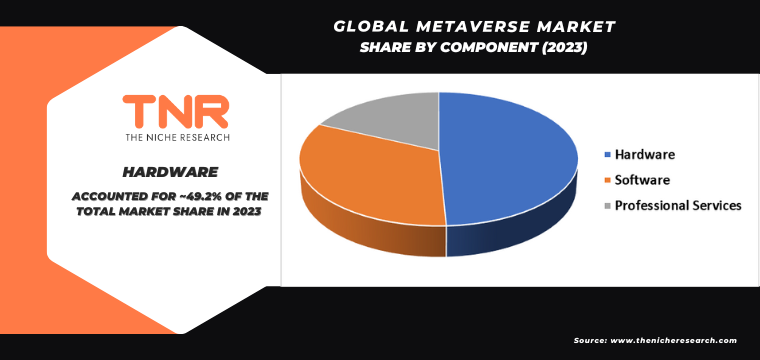
By Industry Vertical Consumer Segment had the Highest Share in the Global Metaverse Market in 2023.
The demand for the metaverse among consumers is driven by several key factors, including the pursuit of immersive digital experiences, advancements in technology, and the increasing integration of virtual spaces in daily life. Consumers are increasingly seeking new forms of entertainment, social interaction, and shopping experiences that go beyond traditional 2D interfaces. The metaverse offers an immersive, interactive environment where users can engage in activities ranging from virtual concerts and gaming to virtual tourism and shopping, creating a dynamic and engaging user experience.
Technological advancements in virtual reality (VR), augmented reality (AR), and blockchain are making these experiences more accessible and realistic, enhancing consumer interest. Moreover, the pandemic has accelerated the adoption of virtual platforms for socializing and entertainment, with consumers spending more time online and exploring new digital venues. The gaming industry, which is a significant component of the metaverse, continues to grow, with consumers demanding more sophisticated and immersive gaming experiences. Additionally, the rise of virtual goods and NFTs (non-fungible tokens) allows consumers to own and trade digital assets, adding a new dimension to their online presence and interactions. These factors collectively drive consumer interest and investment in the metaverse, shaping the future of digital experiences and interactions.
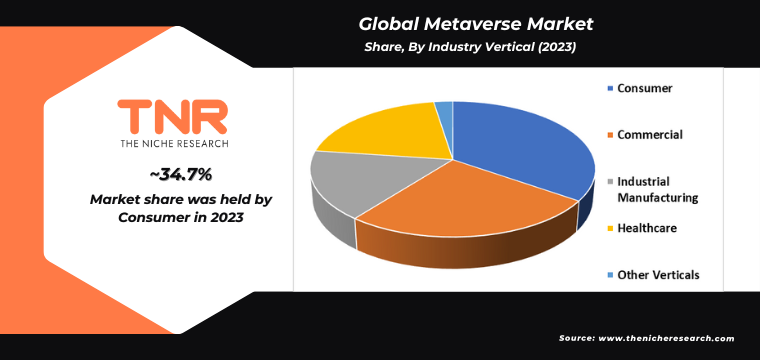
By Region, North America Dominated the Global Metaverse Market in 2023.
In North America, the demand for the metaverse is driven by several key factors, including technological advancements, increased investment from major tech companies, and evolving consumer preferences for immersive digital experiences. Rapid developments in augmented reality (AR), virtual reality (VR), and blockchain technologies are creating robust platforms for metaverse applications, attracting both developers and users.
Major tech giants like Meta (formerly Facebook), Microsoft, and Google are heavily investing in metaverse infrastructure, signaling significant growth potential and fostering innovation in this space. Additionally, the shift towards remote work and virtual social interactions, accelerated by the COVID-19 pandemic, has heightened interest in digital environments where people can work, socialize, and entertain themselves seamlessly. Furthermore, the gaming industry, a key component of the metaverse, continues to expand, with increasing demand for immersive, interactive experiences. These drivers collectively fuel the burgeoning interest and development in the metaverse across North America, paving the way for its integration into various aspects of daily life and business.
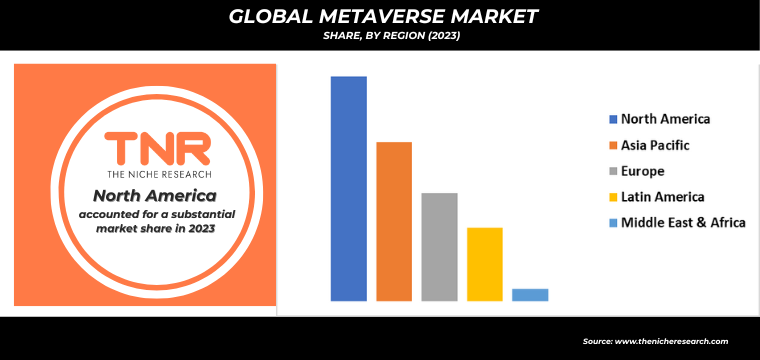
Competitive Landscape: Global Metaverse Market:
- Decentraland
- Epic Games
- META
- Microsoft
- Nextech AR Solutions Inc.
- NVIDIA Corporation
- Qualcomm Technologies, Inc.
- Roblox Corporation
- Snap Inc.
- The Sandbox
- Other Industry Participants
Global Metaverse Market Scope
| Report Specifications | Details |
| Market Revenue in 2023 | US$ 92.5 Bn |
| Market Size Forecast by 2034 | US$ 6,503.2 Bn |
| Growth Rate (CAGR) | 47.2% |
| Historic Data | 2016 – 2022 |
| Base Year for Estimation | 2023 |
| Forecast Period | 2024 – 2034 |
| Report Inclusions | Market Size & Estimates, Market Dynamics, Competitive Scenario, Trends, Growth Factors, Market Determinants, Key Investment Segmentation, Product/Service/Solutions Benchmarking |
| Segments Covered | By Component, By Industry Vertical, By Region |
| Regions Covered | North America, Europe, Asia Pacific, Middle East & Africa, Latin America |
| Countries Covered | U.S., Canada, Mexico, Rest of North America, France, The UK, Spain, Germany, Italy, Nordic Countries (Denmark, Finland, Iceland, Sweden, Norway), Benelux Union (Belgium, The Netherlands, Luxembourg), Rest of Europe, China, Japan, India, New Zealand, Australia, South Korea, Southeast Asia (Indonesia, Thailand, Malaysia, Singapore, Rest of Southeast Asia), Rest of Asia Pacific, Saudi Arabia, UAE, Egypt, Kuwait, South Africa, Rest of Middle East & Africa, Brazil, Argentina, Rest of Latin America |
| Key Players | Decentraland, Epic Games, META, Microsoft, Nextech AR Solutions Inc., NVIDIA Corporation, Qualcomm Technologies, Inc., Roblox Corporation, Snap Inc., The Sandbox |
| Customization Scope | Customization allows for the inclusion/modification of content pertaining to geographical regions, countries, and specific market segments. |
| Pricing & Procurement Options | Explore purchase options tailored to your specific research requirements |
| Contact Details | Consult With Our Expert
Japan (Toll-Free): +81 663-386-8111 South Korea (Toll-Free): +82-808- 703-126 Saudi Arabia (Toll-Free): +966 800-850-1643 United Kingdom: +44 753-710-5080 United States: +1 302-232-5106 E-mail: askanexpert@thenicheresearch.com
|
Global Metaverse Market
By Component
- Hardware
- AR devices
- AR Head-Mounted Displays (HMD)
- AR smart glasses
- Smart helmets
- AR Head-Up Displays (HUD)
- VR devices
- VR Head-Mounted Displays (HMD)
- Gesture-tracking devices and haptics
- MR devices
- Displays
- 3D displays
- Holographic Displays
- Virtual Mirrors
- Software
- Extended Reality Software
- Gaming Engines
- 3D Mapping, Modeling, and Reconstruction
- Metaverse Platforms
- Financial Platforms
- Other Software
- Professional Services
- Application Development and System Integration
- Strategy and business consulting services
- AR devices
By Industry Vertical
- Consumer
- Gaming and Social Media
- Live Entertainment and Events
- Commercial
- Retail and eCommerce
- Education and Corporate
- Travel and Tourism
- Real Estate
- Industrial Manufacturing
- Healthcare
- Other verticals
By Region
- North America (U.S., Canada, Mexico, Rest of North America)
- Europe (France, The UK, Spain, Germany, Italy, Nordic Countries (Denmark, Finland, Iceland, Sweden, Norway), Benelux Union (Belgium, The Netherlands, Luxembourg), Rest of Europe)
- Asia Pacific (China, Japan, India, New Zealand, Australia, South Korea, Southeast Asia (Indonesia, Thailand, Malaysia, Singapore, Rest of Southeast Asia), Rest of Asia Pacific)
- Middle East & Africa (Saudi Arabia, UAE, Egypt, Kuwait, South Africa, Rest of Middle East & Africa)
- Latin America (Brazil, Argentina, Rest of Latin America)
Report Layout:
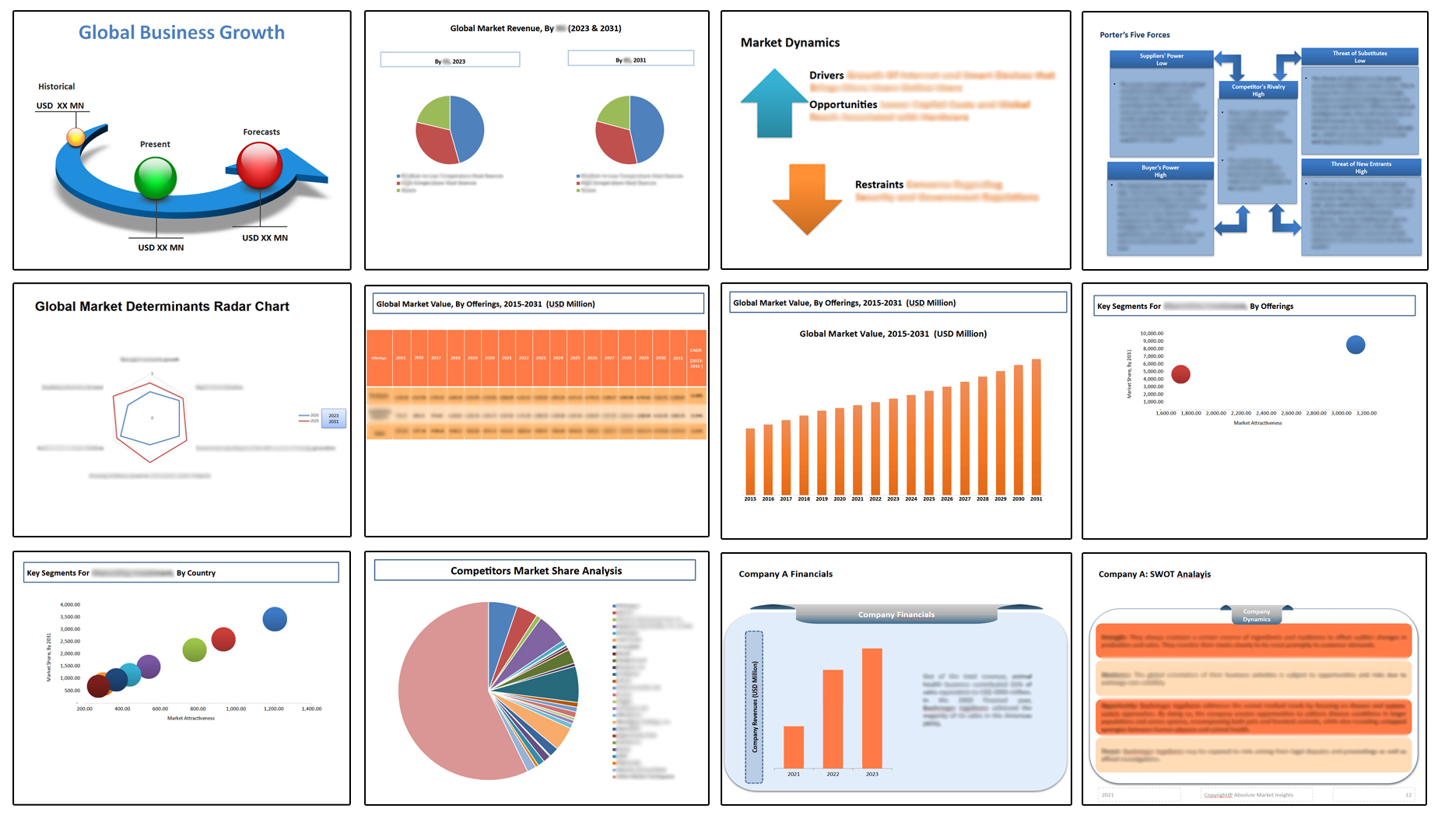
Table of Contents
Note: This ToC is tentative and can be changed according to the research study conducted during the course of report completion.
**Exclusive for Multi-User and Enterprise User.
Global Metaverse Market
By Component
- Hardware
- AR devices
- AR Head-Mounted Displays (HMD)
- AR smart glasses
- Smart helmets
- AR Head-Up Displays (HUD)
- VR devices
- VR Head-Mounted Displays (HMD)
- Gesture-tracking devices and haptics
- MR devices
- Displays
- 3D displays
- Holographic Displays
- Virtual Mirrors
- Software
- Extended Reality Software
- Gaming Engines
- 3D Mapping, Modeling, and Reconstruction
- Metaverse Platforms
- Financial Platforms
- Other Software
- Professional Services
- Application Development and System Integration
- Strategy and business consulting services
- AR devices
By Industry Vertical
- Consumer
- Gaming and Social Media
- Live Entertainment and Events
- Commercial
- Retail and eCommerce
- Education and Corporate
- Travel and Tourism
- Real Estate
- Industrial Manufacturing
- Healthcare
- Other verticals
By Region
- North America (U.S., Canada, Mexico, Rest of North America)
- Europe (France, The UK, Spain, Germany, Italy, Nordic Countries (Denmark, Finland, Iceland, Sweden, Norway), Benelux Union (Belgium, The Netherlands, Luxembourg), Rest of Europe)
- Asia Pacific (China, Japan, India, New Zealand, Australia, South Korea, Southeast Asia (Indonesia, Thailand, Malaysia, Singapore, Rest of Southeast Asia), Rest of Asia Pacific)
- Middle East & Africa (Saudi Arabia, UAE, Egypt, Kuwait, South Africa, Rest of Middle East & Africa)
- Latin America (Brazil, Argentina, Rest of Latin America)
The Niche Research approach encompasses both primary and secondary research methods to provide comprehensive insights. While primary research is the cornerstone of our studies, we also incorporate secondary research sources such as company annual reports, premium industry databases, press releases, industry journals, and white papers.
Within our primary research, we actively engage with various industry stakeholders, conducting paid interviews and surveys. Our meticulous analysis extends to every market participant in major countries, allowing us to thoroughly examine their portfolios, calculate market shares, and segment revenues.
Our data collection primarily focuses on individual countries within our research scope, enabling us to estimate regional market sizes. Typically, we employ a bottom-up approach, meticulously tracking trends in different countries. We analyze growth drivers, constraints, technological innovations, and opportunities for each country, ultimately arriving at regional figures.Our process begins by examining the growth prospects of each country. Building upon these insights, we project growth and trends for the entire region. Finally, we utilize our proprietary model to refine estimations and forecasts.
Our data validation standards are integral to ensuring the reliability and accuracy of our research findings. Here’s a breakdown of our data validation processes and the stakeholders we engage with during our primary research:
- Supply Side Analysis: We initiate a supply side analysis by directly contacting market participants, through telephonic interviews and questionnaires containing both open-ended and close-ended questions. We gather information on their portfolios, segment revenues, developments, and growth strategies.
- Demand Side Analysis: To gain insights into adoption trends and consumer preferences, we reach out to target customers and users (non-vendors). This information forms a vital part of the qualitative analysis section of our reports, covering market dynamics, adoption trends, consumer behavior, spending patterns, and other related aspects.
- Consultant Insights: We tap into the expertise of our partner consultants from around the world to obtain their unique viewpoints and perspectives. Their insights contribute to a well-rounded understanding of the markets under investigation.
- In-House Validation: To ensure data accuracy and reliability, we conduct cross-validation of data points and information through our in-house team of consultants and utilize advanced data modeling tools for thorough verification.
The forecasts we provide are based on a comprehensive assessment of various factors, including:
- Market Trends and Past Performance (Last Five Years): We accurately analyze market trends and performance data from preceding five years to identify historical patterns and understand the market’s evolution.
- Historical Performance and Growth of Market Participants: We assess the historical performance and growth trajectories of key market participants. This analysis provides insights into the competitive landscape and individual company strategies.
- Market Determinants Impact Analysis (Next Eight Years): We conduct a rigorous analysis of the factors that are projected to influence the market over the next eight years. This includes assessing both internal and external determinants that can shape market dynamics.
- Drivers and Challenges for the Forecast Period:Identify the factors expected to drive market growth during the forecast period, as well as the challenges that the industry may face. This analysis aids in deriving an accurate growth rate projection.
- New Acquisitions, Collaborations, or Partnerships: We keep a close watch on any new acquisitions, collaborations, or partnerships within the industry. These developments can have a significant impact on market dynamics and competitiveness.
- Macro and Micro Factors Analysis:A thorough examination of both macro-level factors (e.g., economic trends, regulatory changes) and micro-level factors (e.g., technological advancements, consumer preferences) that may influence the market during the forecast period.
- End-User Sentiment Analysis: To understand the market from the end-user perspective, we conduct sentiment analysis. This involves assessing the sentiment, preferences, and feedback of the end-users, which can provide valuable insights into market trends.
- Perspective of Primary Participants: Insights gathered directly from primary research participants play a crucial role in shaping our forecasts. Their perspectives and experiences provide valuable qualitative data.
- Year-on-Year Growth Trend: We utilize a year-on-year growth trend based on historical market growth and expected future trends. This helps in formulating our growth projections, aligning them with the market’s historical performance.
Research process adopted by TNR involves multiple stages, including data collection, validation, quality checks, and presentation. It’s crucial that the data and information we provide add value to your existing market understanding and expertise. We have also established partnerships with business consulting, research, and survey organizations across regions and globally to collaborate on regional analysis and data validation, ensuring the highest level of accuracy and reliability in our reports.









